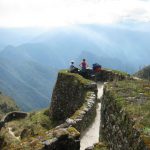As our line of work pushes us around the globe throughout the year, some of us at CAT have recently chosen to ignore the conventional wisdom regarding traveling with kids. Of course, this poses more of a problem at some destinations than others. Take our recent visit to Machu Picchu, Peru for example. Traveling with an infant or small baby to someplace that’s not only off the beaten track but located at an unusually high altitude seems like it would be a risky venture, not only for the success of your trip, but for the health of your child. Since Machu Picchu is located at an elevation of 2,500 meters (8,200 feet) in Peru’s high Andes, even seasoned adult travelers are wise to be wary of Altitude Sickness (otherwise known as “Soroche”) that often accompanies trips to Machu Picchu.
While we are on the subject of ‘Soroche’, let’s take a moment to review its causes and effects:
Altitude Sickness or ‘Soroche’ is caused by 2 main factors:
1. Lack of oxygen in the air
The higher you ascend in altitude, the less oxygen there is in the air so therefore your lungs aren’t getting as much oxygen to your brain and heart for each breath you take as they normally would. Since you have to inhale more often to get the usual amount of oxygen into your body it leaves you with the constant feeling of being ‘out of breath’.
2. Lower air pressure at higher altitudes
At an altitude of 3,400m (app. 10,000ft) there is that much less air/air-pressure pushing down on your body then sea-level (0m). At lower altitudes, a body has had to build up certain pressure within in order to withstand the outside air-pressure. This is done through nitrogen bubbles in your bloodstream. These bubbles create inner pressure and equilibrium with the forces of the outside air pressure. Once you reach a certain altitude very quickly (while flying, for example), your body may have difficulties adjusting itself to the sudden difference in outside pressure and for a while (usually a maximum of 24 hours) your inside pressure may be higher than the outside air-pressure, causing a series of possible discomforts, such as headache, dizziness, intestinal unrest, etc. This all has to do with the fact that your body tries to make the nitrogen bubbles in your bloodstream smaller and readjust itself to the outside pressure, but hasn’t gotten there yet. Normally this is no big problem and you will get over it within 24 hours.
So, back to the issue at hand; should you take the kids with you to the elevated altitudes of Machu Picchu and the Peruvian Andes? Some medical research suggests that young children rarely suffer from the effects of altitude sickness, as their bodies tend to adjust themselves much faster than those of adults, however you should still take things slow and be aware of their responses. People might ask: ‘Why would you take them somewhere, at that age, when they probably won’t have any recollection of it later?’
It’s been our experience that children are as receptive to travel experiences as they are to languages at that age; their mind is a sponge and they can absorb lots of valuable information from a trip like this. While they may not consciously remember all the details as they grow up, you know that at some level their minds are opening up as they are taking in the new sights and sounds with all the curiosity and wonderment that is unique and common in young children.
We’ve had nothing but positive experiences traveling with our young children and we feel comfortable about doing so until proven otherwise. We sincerely feel that getting to know different cultures and ways of living will help and accustom kids to becoming tolerant teenagers and adults – and as far as learning tolerance goes, there is no better time than the present!
Thanks for visiting our Central & South America Travel Blog! Feel free to contact one of our Travel Specialists via email, phone or chat to plan your perfect Peru travel itinerary.





